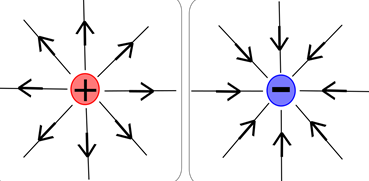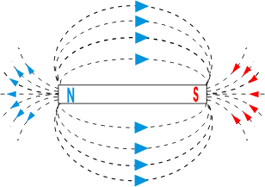Key Concepts
The physical field extending throughout space that delivers electric and magnetic effects. The electromagnetic field is a unified field that consists of two inseparable components, the electric field and the magnetic field (Fig. 1 and Fig. 2). Fundamentally, electromagnetic fields are created by particles with electric charge or magnetic moment. However, the field itself does not carry electric charge, magnetic moment, or mass. Therefore, one electromagnetic field cannot directly interact with another electromagnetic field. Electromagnetic fields carry energy and momentum which they can give to particles with electric charge or magnetic moment. In high-energy events, electromagnetic fields can create or destroy particles. See also: Electric charge; Electromagnetism; Elementary particle; Energy; Magnetism; Mass; Momentum


Types of electromagnetic fields
In general, the electromagnetic field can take on five forms.
- Electrostatic fields, in which the electric field is not changing and the magnetic field is so weak that it can be ignored. An example is the field surrounding a statically charged sock. See also: Electric field
- Magnetostatic fields, in which the magnetic field is not changing and the electric field is so weak that it can be ignored. An example is the field surrounding a motionless refrigerator magnet. See also: Magnet
- Electroquasistatic fields, in which both the electric field and the magnetic field are gradually changing and the electric field dominates. An example is the field inside a computer keyboard.
- Magnetoquasistatic fields, in which both the electric field and magnetic field are gradually changing and the magnetic field dominates. An example is the field inside an electric motor. See also: Motor
- Electromagnetic waves, in which both the electric field and magnetic field are rapidly changing. These waves are also referred to as electromagnetic radiation or light. All forms of light are electromagnetic waves, including radio waves, infrared waves, visible light, ultraviolet rays, x-rays, and gamma rays. Electromagnetic waves are emitted any time an object with electric charge or magnetic moment accelerates. See also: Electromagnetic radiation; Electromagnetic wave; Light
The nature of electromagnetic fields
The creation and behavior of electromagnetic fields are dictated by four physical laws that are collectively known as Maxwell’s equations. These laws are as follows: (1) Gauss’s law states that a particle with electric charge will create an electric field with a diverging pattern; (2) Gauss’s law for magnetism states that magnetically charged particles do not exist and therefore magnetic fields can never have a diverging pattern; (3) Faraday’s law of induction states that a changing magnetic field will create an electric field with a curling pattern; and (4) the Ampère-Maxwell law states that both a moving electrically charged particle and a changing electric field will create a magnetic field with a curling pattern. Maxwell’s equations implicitly contain other physical laws, such as the laws of optics, the electric circuit laws, and various conservation laws. See also: Maxwell's equations
Fundamentally, the electromagnetic field consists of a collection of discrete, indivisible quantum packets called photons. The most accurate description of the electromagnetic field is the quantum field version of Maxwell’s equations, which are collectively known as quantum electrodynamics (QED). Furthermore, QED unites the quantum field version of electromagnetism with the special theory of relativity. See also: Photon; Quantum electrodynamics; Relativity





